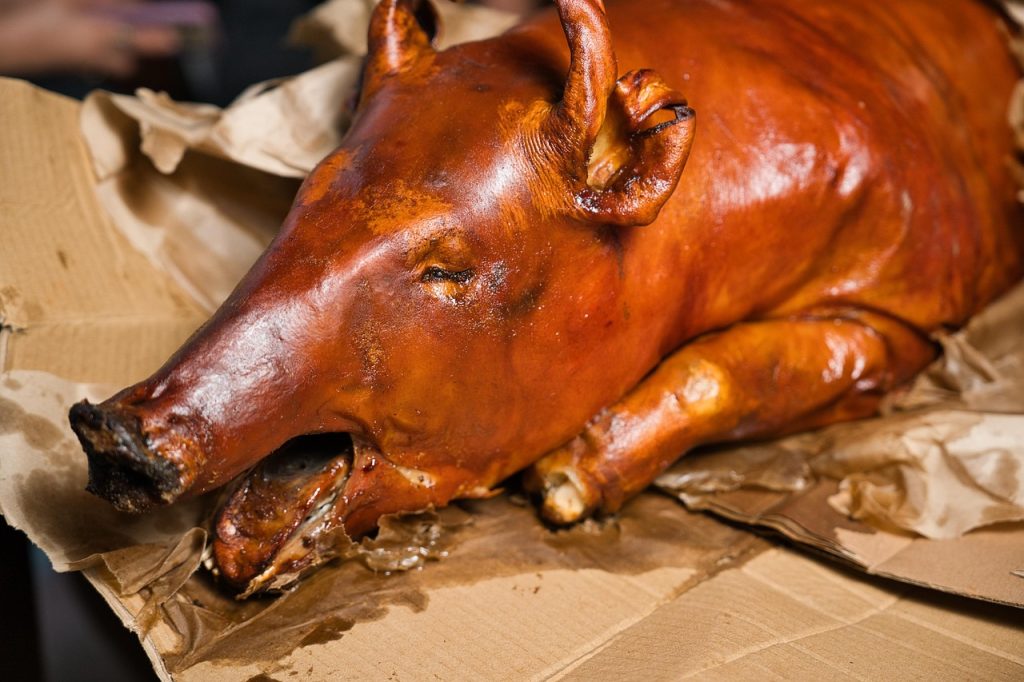
Lechon is more than just food in the Philippines—it’s a symbol of celebration, family, and tradition. This slow-roasted whole pig, with its crispy golden skin and tender, flavorful meat, has been a centerpiece of Filipino feasts for generations. But what makes lechon so special? In this guide, we’ll dive deep into the history, types, cooking techniques, and business opportunities surrounding lechon. Whether you’re a food enthusiast, an aspiring lechonero, or someone looking for the best lechon in the Philippines, this article will provide everything you need to know.
What is Lechon?
Lechon is a whole pig roasted over an open fire or charcoal pit for several hours, resulting in a crispy, crackling skin and juicy, flavorful meat. It is traditionally seasoned with salt, garlic, lemongrass, bay leaves, and other spices to enhance its taste. The slow-roasting process allows the fat to render, giving lechon its signature crispiness and mouthwatering aroma.
In the Philippines, lechon is not just a dish—it’s an experience. It’s often the highlight of birthdays, weddings, fiestas, and special gatherings.
History of Lechon in the Philippines
Lechon originated from the Spanish word lechón, which means “roasted suckling pig.” Although roasting pigs dates back centuries, it became deeply embedded in Filipino culture during the Spanish colonization. Over time, Filipinos developed their own unique styles and flavors, leading to the regional variations of lechon we know today.
Types of Lechon in the Philippines
1. Cebu Lechon
Cebu lechon is widely regarded as the best lechon in the Philippines. What makes it unique? Unlike traditional lechon, Cebu-style lechon does not require a sauce because its meat is already well-seasoned and flavorful. It is stuffed with lemongrass, garlic, onions, and various spices before roasting, creating a bold, aromatic taste.
2. Luzon-Style Lechon
Lechon in Luzon is typically served with a liver-based sauce called lechon sauce or sarsa. The skin is crunchy, and the meat is often less salty compared to its Cebu counterpart.
3. Lechon de Leche
This is a smaller version of traditional lechon, using a young pig (suckling pig) instead of a full-grown one. Lechon de leche is more tender and delicate in flavor, often reserved for intimate celebrations.
4. Lechon Belly
A modern twist on lechon, this variation focuses on the pork belly instead of the whole pig. The meat is rolled, seasoned, and roasted, making it more convenient for smaller gatherings while maintaining the crispy texture and rich flavors of traditional lechon.
5. Lechon Manok
For those who prefer chicken, lechon manok (roast chicken) is a popular alternative. It is marinated in a mixture of soy sauce, calamansi, and spices before being roasted over charcoal.
How to Cook the Perfect Lechon
Ingredients:
- Whole pig (10-20 kg)
- Salt and pepper
- Garlic, crushed
- Lemongrass
- Bay leaves
- Onion, chopped
- Soy sauce (optional)
- Vinegar (for basting)
Steps to Roast a Traditional Lechon:
- Prepare the pig – Clean and remove the internal organs. Pat dry and rub the inside and outside with salt and pepper.
- Stuff the pig – Fill the pig’s belly with lemongrass, garlic, onions, and bay leaves. Sew it shut using butcher’s twine.
- Skewer the pig – Insert a long bamboo pole through the pig’s body for even roasting.
- Slow-roast over charcoal – Place the pig over an open fire or pit, rotating it continuously for 4-6 hours. Baste with vinegar or oil to enhance crispiness.
- Check for doneness – The skin should be golden brown and crispy, while the meat should be juicy and tender.
- Serve and enjoy – Chop into pieces and serve with dipping sauces like vinegar, soy sauce, or liver sauce.
Best Places to Eat Lechon in the Philippines
If you want to taste the best lechon in the Philippines, check out these top destinations:
- Cebu: Rico’s Lechon, Zubuchon, CNT Lechon
- Manila: Lydia’s Lechon, Mila’s Lechon, Elar’s Lechon
- Davao: Davao’s Best Lechon
- Iloilo: Tatoy’s Manokan & Seafood
Lechon Business: How to Start Your Own Lechon Business
1. Conduct Market Research
Study the local demand for lechon. Identify competitors and find ways to offer something unique.
2. Secure Permits and Licenses
Register your business with DTI (Department of Trade and Industry) or SEC (Securities and Exchange Commission). Get permits from your local government and the Bureau of Internal Revenue (BIR).
3. Find a Supplier
Look for a reliable supplier of high-quality pigs. Establish partnerships with farms or trusted local butchers.
4. Perfect Your Recipe
Your lechon should stand out. Experiment with different marinades, stuffing, and roasting techniques.
5. Invest in Equipment
You’ll need roasting pits, bamboo skewers, charcoal, and storage for ingredients.
6. Set Up Delivery and Online Ordering
Offer home deliveries through social media and food delivery apps. A strong online presence can help boost sales.
7. Market Your Business
Use Facebook, Instagram, and TikTok to showcase your lechon. Offer promotions during holidays and special occasions.
Health Tips: How to Enjoy Lechon Without Guilt
Lechon is undeniably delicious, but it’s also high in fat. Here are some tips to enjoy it in a healthier way:
- Eat in moderation – Limit your serving size.
- Pair with vegetables – Balance the meal with fresh greens or vinegar-based salads.
- Remove excess fat – Trim off fatty portions if needed.
- Exercise regularly – Maintain an active lifestyle to offset indulgences.
Frequently Asked Questions About Lechon
1. What is the difference between Cebu lechon and Manila lechon?
Cebu lechon is saltier and does not require sauce, while Manila lechon is often served with a liver-based sauce.
2. How much does a whole lechon cost in the Philippines?
Prices vary, but a whole lechon typically ranges from ₱6,000 to ₱12,000, depending on size and location.
3. Can I order lechon for delivery?
Yes! Many lechon businesses now offer delivery through online orders.
4. What is the best way to reheat leftover lechon?
The best method is to air-fry or bake it in an oven to retain its crispiness. Avoid microwaving, as it makes the skin soggy.
Conclusion
Lechon is more than just a dish—it’s a Filipino tradition that brings people together. Whether you’re cooking it at home, ordering from a famous lechon house, or starting your own lechon business, understanding its history, variations, and best practices will help you appreciate this iconic Filipino delicacy even more.
If you’re craving lechon now, go ahead and indulge! Just remember to enjoy it in moderation and share it with family and friends.
Did you find this guide helpful? Share it with fellow lechon lovers and let us know your favorite lechon experience in the comments!

